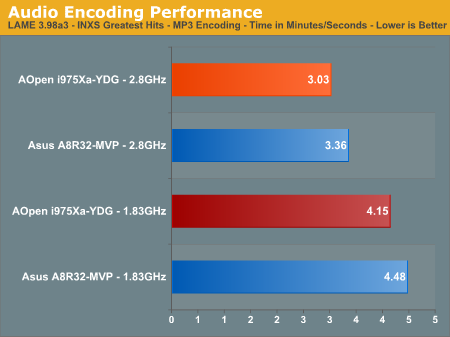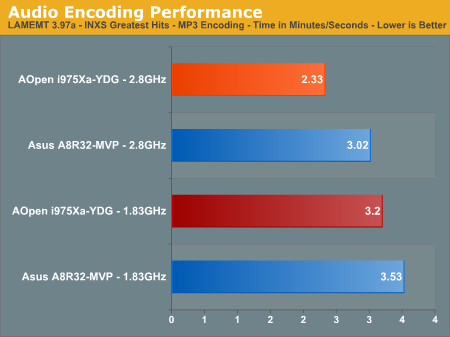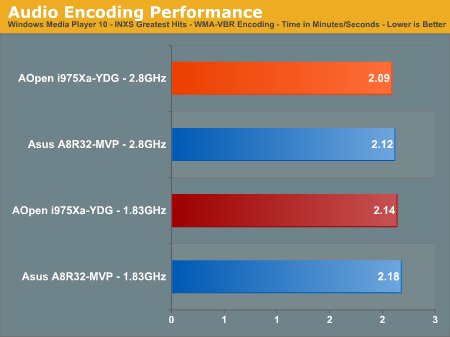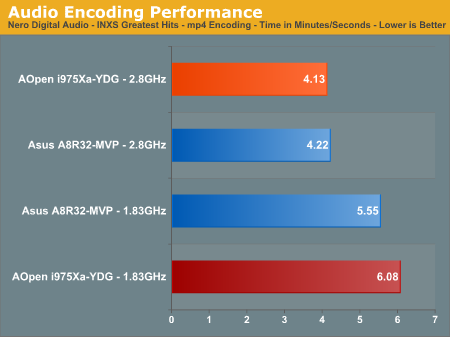Intel Core Duo: AOpen i975Xa-YDG to the Rescue
by Gary Key on May 4, 2006 8:00 AM EST- Posted in
- Motherboards
Audio Encoding Performance
While the media encoding prowess of the Intel processors has been lacking at times, they have generally faired a little better on the audio side. Our audio test suite consists of Exact Audio Copy v095.b4, LAME 3.98a3, LAME MT 3.97a-MS Compiler, Windows Media Player 10, and Nero Digital Audio.Our first task was to figure out what test CD to utilize. We needed one that contained a significant number of tracks and had over 600MB of data in order to properly stress our platforms. After rummaging around the lab and discounting the Burl Ives Greatest Christmas Hits album, we happened upon a CD that would work for our purposes as it was not working for anyone else, INXS Greatest Hits. This one time '80s glory masterpiece contains 16 tracks totaling 606MB of songs that was instantly whisked into our anxiously awaiting optical drive.
Our first test consists of utilizing Exact Audio Copy as the front end for our differing versions of LAME. We setup EAC for variable bit rate encoding, burst mode for extraction, use external program for compression, and to start the external compressor upon extraction (EAC will read the next track while LAME is working on the previous track, thus removing a potential bottleneck with the drive).
Our two versions of LAME consist of the recently released 3.98a3 and LAME MT 3.97a, which is a multi-threaded version of the LAME MP3 encoder. LAME MT was originally designed as a demonstration to show the advantages of multi-threading on the Pentium 4 with Hyper-Threading enabled. Instead of running multiple parallel threads, LAME MT generates the encoder's psycho-acoustic analysis function in a separate thread from the rest of the encoder using a simple linear pipeline and then caches it in the second thread for processing. Further details about the program and its creation can be found here. The results are presented in minutes/seconds for the encoding process, with lower numbers being better.


As in the media encoding section, the more CPU intensive operations seem to favor the Intel platform. We ran these tests several times with the results all being within one second of each other. If we shortened the test to 6 tracks then the AMD platform was within a couple of percent of the Intel platform. As we extended the size of our test samples the performance margin between the two platforms lengthened from a 2% advantage for the Intel platform to almost 11%. It concerned us to the point that we changed our drive image and then our board. We were rewarded with the same results. Running this same test on our 945GM based board resulted in a performance difference around 4% in favor of the Intel platform.
When utilizing LAME MT we see upwards of a 29% improvement in encoding times resulting in scores near that of our overclocked results. This once again shows the advantages programs can gain when they're written to take advantage of multiple-core processors or platforms.
Our next test consists of utilizing the INXS Greatest Hits CD and ripping all 16 tracks with Windows Media Player 10. We set WMP10 to rip the tracks in Widows Media Audio variable bit rate format and moved the slider all the way to the right resulting in a Best Quality request.

The results are very close for both platforms and the only comment here is that a fast optical drive is probably more important than your choice of CPU in this benchmark.
Our last audio test - and we are sure our INXS Greatest Hits CD is ecstatic about this - utilizes Nero Digital Audio to extract all 16 tracks and convert them into an mp4 format. We changed the default quality settings to transcoder-ultra, variable bit rate, encoder quality to high, and the AAC profile to LC. We were determined to give our platforms a workout with this test.

These results invoked the burning of the midnight oil along with some late night phone calls to Nero. In the end, after numerous retests and a run to Best Buy to purchase another copy of the INXS Greatest Hits CD - just to make sure CD scratches weren't causing problems - we have a situation where the AMD platform has a clear advantage at the stock settings in a program that heavily stresses the CPU subsystem. However, the Intel platform shines at the overclocked settings resulting in scores that do not follow any previous patterns in our test results.
We ran these tests over a dozen times with the same results. We noticed that on the last four tracks the Intel system would encode these files quicker than the AMD system, even though the track speed of our optical drive did not change. We thought perhaps our Opteron system was encountering some form of thermal throttling, but our temperature readings showed very little change, and adding active cooling to our OCZ memory still generated the same results.










81 Comments
View All Comments
Gary Key - Friday, May 5, 2006 - link
Sorry, being a selfish s.o.b. with this drive, actually I am testing two of them for an upcoming article. :)
sabrewulf - Thursday, May 4, 2006 - link
I haven't been following the development of Conroe too closely, but isn't this chip essentially performing like Conroe will? Or am I missing something?Some of the tests were impressive, but the gaming tests were certainly not "20-40%" improvement over AMD like everyone is wishing.
MrKaz - Thursday, May 4, 2006 - link
And "will" never be.Don’t forget Intel was using:
- Some special ATI driver.
- Crossfire setup (maybe modified),
20%~40% that you will never get, unless you have such kind of configuration.
On non SLI/Crossfire configuration will never be higher than 5%, 10% improvement...
And thanks that a lot to the 4MB cache, and minor processor (P3 redesign) changes.
Don’t forget that the Intel dual core with 4MB shared cache can act as one BIG single core processor with 4MB cache and the second core with 0MB of cache for the extra “stupid” calc...
IntelUser2000 - Thursday, May 4, 2006 - link
LOL. I always doubt that people can be such a dumb fanboy even I see them over and over again in time.
How do you explain Xtremsystems benchmark, and all the architectural advantages?? Did Netburst's poor showing really blind you??
MrKaz - Friday, May 5, 2006 - link
Fun boy me?It's you who calls him self by the stupid nick name Inteluser2000.
Some time there are complete morons here and you are one of them.
ME the "fan boy" has to "defend" Intel, a thing that you with your little brain can’t do.
Read my reply to your fan boy friends, there you will find why conroe will be good, and it's not because it's Intel.... dumb moron....
redbone75 - Thursday, May 4, 2006 - link
I don't think it was a "special" driver per se, if I recall the driver had some changes made in order to recognize Conroe.
I just love how a lot of people refer to Conroe as a P3 redesign as if it's something so bad. No, it's not a P3 redesign, there are elements of what made the P3 so successful incorporated into the chip, but that's not what makes the chip so awesome. Also, so what if it is ultimately just a "P3 redesign" as you put it? You use what works, and obviously this works. Hey, the K7 core was pretty good, and K8 is so well designed that AMD can ride it for a few more years.
MrKaz - Friday, May 5, 2006 - link
"in order to recognize Conroe"Why they need to recognize Conroe?
-Would work?
-Did work but with inferior performance?
-Special optimizations?
-New instruction set (SSE4) support for improved performance?
Questar - Thursday, May 4, 2006 - link
Wow, some fanboys are still in denial.This is an interim MOBILE chip that just put the smack down on an Opteron. What's going to happen when the real thing comes out?
MrKaz - Friday, May 5, 2006 - link
When the real thing come out? That’s easy:Core duo plus:
- 2MB cache (+5%~10%)
- 2X FSB (+4%~8%)
- 800Mhz DDR2 (3%~6%)
- x64 support (0%)
- Higher clock speed 2.1Ghz to 3.3Ghz (anyone can say 50% performance increase?)
I’m not a fan boy, it’s you Intel stupid morons that can even read and make some thought why should Conroe be faster than AMD Athlon 64….
Go back and reread the article about:
Intel Core versus AMD's K8 architecture
Don’t expect conroe be very different from core duo... I’m not saying that’s bad…
Questar - Friday, May 5, 2006 - link
You forgot a couple of things:Addidtional ALU Unit
Twice the SSE performace
Better code reordering
Larger reservation station
New micro-ops